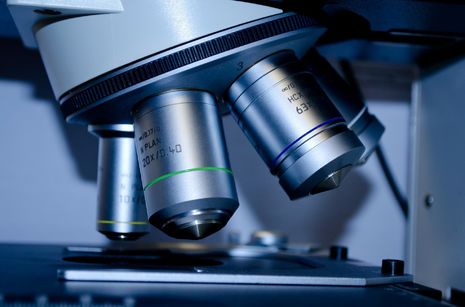Brain organoids and species named after Taylor Swift: this year’s research highlights
Sambhavi Sneha Kumar, Julia Dabrowska and Emily Sissons on their favourite pieces of research from this academic year

Significant progress has been made in the last year in several disciplines of science. For example, over the winter we saw the launch of the James Webb Space Telescope, carrying with it the potential to revolutionise the fields of astronomy and cosmology. In May, astronomers of the Event Horizon Telescope (EHT) Collaboration released direct images of the black hole at the centre of our galaxy for the first time. As the world recovers from the effects of COVID-19, which placed a temporary emergency brake on scientific progress in several fields, the last year has seen a global drive to restore research initiatives and resume projects that may have been placed on hold. We’ve rounded up some of favourite pieces of research from the last year, from Cambridge and elsewhere.
Growing mini brains to help us understand neurological disease
What could we do if we could grow brains in the laboratory? For one, we could use model brain organoids to enhance our understanding of neurodegenerative disease. The term “organoid” refers to a three-dimensional mass of cells that represents a human organ. Organoids are typically derived from skin cells which are reprogrammed back to their stem cell stage, and subsequently grown up to form a three-dimensional culture. These have already been used extensively in several fields of research – for example, in studying the early stages of pregnancy – and new work with organoids is of increasing promise.
Researchers at the John van Geest Centre for Brain Repair, University of Cambridge reached a new milestone when they used stem cells derived from a patient suffering with motor neurone disease and dementia to grow a tiny brain organoid – roughly the size of a pea. While its size may seem unassuming, this organoid was grown for 240 days successfully at the time of initial publication, longer than ever previously. What’s more, the group, led by Dr András Lakatos, were able to identify a particular drug that improved outcomes at the cellular level: reducing the accumulation of toxic proteins, reducing cellular stress, and reducing nerve loss.
Given that current clinical approaches targeting neurodegenerative disease are often limited in their success, and that aspects of the pathogenesis of neurodegenerative disease remain poorly understood, the use of organoids may help to shed light on novel therapeutic strategies. In the words of Dr Lakatos: “By modelling some of the mechanisms that lead to DNA damage in nerve cells and showing how these can lead to various cell dysfunctions, we may also be able to identify further potential drug targets.”
“The use of organoids may help to shed light on novel therapeutic strategies”
Xenogeneic heart transplants
On 10 January, scientists in the United States reported the first successful xenogeneic heart transplant (a transplant from another animal, in this case a genetically modified pig, to a human), offering hope to the many patients waiting for this vital organ. Heart transplants are high in demand, but short in supply: in the UK, the average wait time for deceased human donor hearts is 18-24 months, and about a dozen people die daily waiting for organs in the US. Therefore, this breakthrough offers new hope and potential to patients suffering from life-threatening heart diseases, increasing the number of transplantable hearts available and reducing waiting times.
But why was this so difficult before? A key problem with transplants is the host’s immune response, which sees the transplant as a foreign body and mounts immune attacks against it, leading to rejection of the organ, infections, and possible severe side effects such as graft-versus-host disease or cancer. These are already problematic in human-to-human transplants, but transplants from another species are on another level of difficulty, as human organs clearly share a much larger proportion of genetic material than inter-species ones, which are rejected as not only non-self, but also not belonging to the recipient’s species.
To overcome these difficulties, the heart transplant used here was genetically altered to minimise the risks of immune rejection, made possible by recent advances in gene cloning, editing and recombination technologies. Four pig genes were knocked out, including one mounting an aggressive human immune response, and six human ones to facilitate acceptance of the transplant were added. In addition, pigs offer many advantages: they are easy to raise, and organs can achieve adult size in only six months.
Challenges with immune rejection, reliability (how long will these transplanted tissues last?) and ethical issues exist. We likely still have a long way to go in the field of xenogeneic transplants. Critically, the recipient of the pig heart passed away around two months after the surgery (though notably no specific cause of death was identified). This surgery is likely a cornerstone for solving organ shortages and transplantation issues in the future.
Discoveries of new species
Estimates suggest there are 8.7 million species of animals, plants, fungi and algae on Earth, yet only around 1.2 million have been formally identified so far. However, scientists are constantly discovering new species around the world, and in the past year, many of these species have had interesting stories to tell.
“Scientists are constantly discovering new species around the world”
In the so-called “Twilight Zone” of the ocean, its deepest, darkest, and most unknown region, a pink-coloured, delicate fish has been discovered: the Cirrhilabrus rubrisquamis, known as the rose-veiled fairy wrasse. Inhabiting the coral reefs off the coast of the Maldives, this stunning fish is crucial to the biodiversity of these fragile ecosystems, but, so soon after its discovery, is already being targeted by the commercial aquatics industry for sale as pets.
The Amazon rainforest, home to 10% of all the world’s known species, has also yielded yet another new find – the Tapir frog (Synapturanus danta). Discovered in the Peruvian Amazon, this frog has remained elusive for so long due to its habit of burrowing into the ground, which, combined with its velvety, chocolate-brown-coloured body, makes it well camouflaged against predators but difficult for scientists to spot. Its colouring has also led to the species being nick-named “chocolate frogs” because of their close resemblance to the similarly named magical animal in the popular Harry Potter series.
Finally, the Nannaria swiftae is a small brown centipede discovered in the Appalachian Mountains of the United States, one of 17 newly discovered centipede species. Despite its unassuming nature, the Nannaria swiftae is not only an integral part of its native forest ecosystems, responsible for breaking down organic matter and releasing key nutrients into the soil, it also shares its name with American singer Taylor Swift, who Swift-fan and researcher Derek Hennen named it after.
A promising year ahead
This article has highlighted just some of the most interesting developments in science over the last 12 months. The next year will hopefully offer more promising ventures as we continue to understand our own bodies and the world around us.
 News / Eight Cambridge researchers awarded €17m in ERC research grants27 December 2025
News / Eight Cambridge researchers awarded €17m in ERC research grants27 December 2025 News / Downing investigates ‘mysterious’ underground burial vault 29 December 2025
News / Downing investigates ‘mysterious’ underground burial vault 29 December 2025 Lifestyle / Ask Auntie Alice29 December 2025
Lifestyle / Ask Auntie Alice29 December 2025 Sport / Hard work, heartbreak and hope: international gymnast Maddie Marshall’s journey 29 December 2025
Sport / Hard work, heartbreak and hope: international gymnast Maddie Marshall’s journey 29 December 2025 Interviews / Meet Juan Michel, Cambridge’s multilingual musician29 December 2025
Interviews / Meet Juan Michel, Cambridge’s multilingual musician29 December 2025










